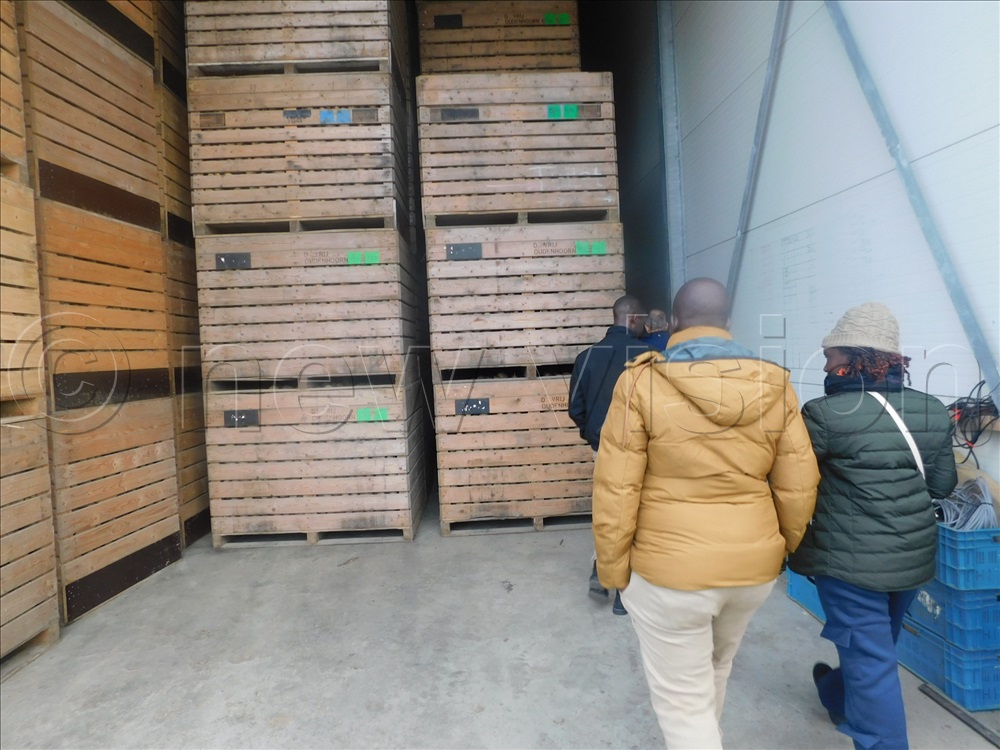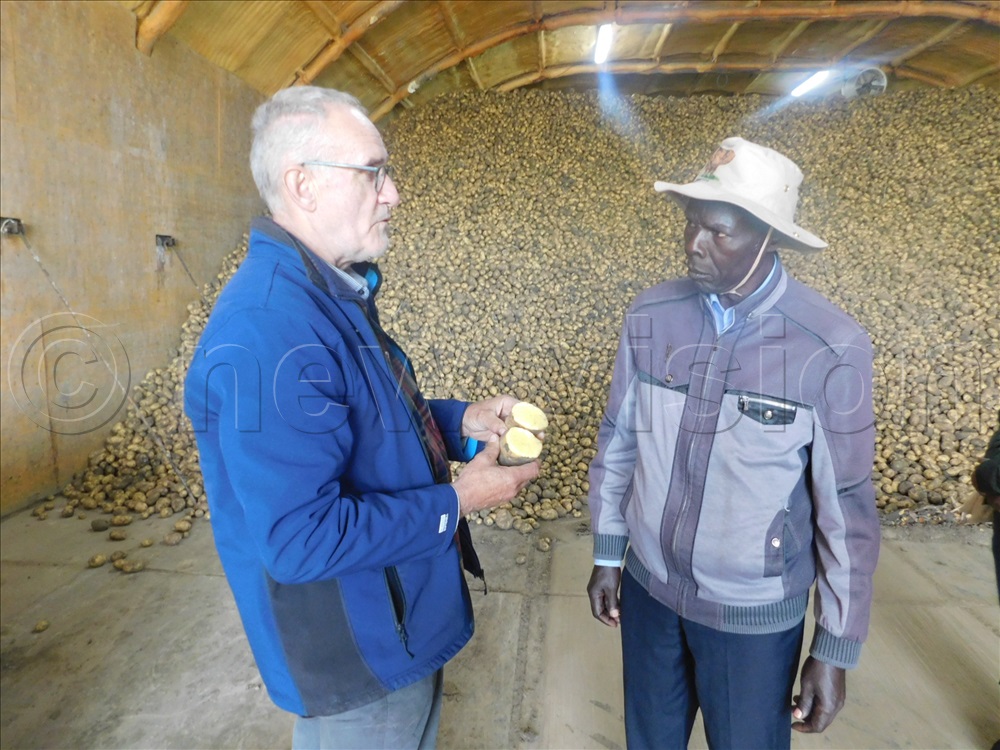By Joshua Kato
On the outside, the produce storage facility at Agra Nova looks like an ordinary warehouse. But when a group of Uganda’s top farmers entered the building, they realised that it was more than just a warehouse.
It is part of a massive Irish potato and onion storage facility, owned by Meindert den Ouden, a farmer in Dwarsweg, Zuiland, the Netherlands.
The farm grows potatoes and onions on over 250 acres before exporting most of the produce to European countries, including Spain.
Learning journey
On October 16, a team of three farmers who garnered the top spots in last year’s Best Farmers Competition were driven from the Dutch city of Den Bosch, through the port of Rotterdam to visit this farm.
The farmers included Bosco Otto, Dr Pamela Bakabulindi and Solomon Odong. The purpose was to get exposed to the ‘way of the Dutch horticulture farmer’.

The visiting farmers were welcomed by den Ouden and Tom Borghois, an expert from PUM, a business-oriented organisation.
The warehouse sits at the edge of an open field, on the outskirts of Rotterdam.
In addition to the warehouse, there is a fairly large residential house plus another hangar used for keeping the farm equipment, including tractors.
This area, den Ouden said, is the heart of open-field crop production in the Netherlands.
The farm is the epitome of top-notch potato and onion-producing technology, including a sensor-powered storage facility, intelligent combine harvesters and artificial intelligence-operated sprayers.
“The temperature in the warehouse is regulated by computers,” den Ouden said.
Perhaps this is a notch higher for the Ugandan farmers, but it showed them how far a commercial farmer can go to achieve the expected yields.
The farmers visited the Netherlands between October 12 and October 18.
Den Ouden said the Netherlands is among the top five producers of potatoes in the world.
The country has 3,000 potato growers producing over seven million tonnes of the tuber each year.
According to statistics, about 70% of the produce is exported as fresh food to Europe and Asia. Another 700,000 tonnes are exported as seed.
Old generational farm
As with most Dutch farms, Agra Nova is over 100 years old. “It used to be a mixed farm with dairy and crops,” den Ouden said. But 35 years ago, the farm decided to concentrate on crops.

Currently, 25% of the land is used for growing potatoes. However, they also grow onions, sugar beet, carrots and winter wheat.
“We use an intensive system to produce the potatoes,” he said.
This includes the use of the best seeds, planting, weeding, spraying and harvesting equipment.
“You realise that labour costs are too high here. So, farmers had to turn to machines to do the work,” he said.
Ironically, because of the mechanisation, the farm has just two workers.
“It is only me and my son who permanently work here,” den Ouden said.
Comparatively, a farm of that size in Uganda would employ at least 100 workers.
“I am impressed by the processes here,” Dr Bakabulindi said.
“You do not see this farmer compromising any of the processes.”
Potato scarcity in Uganda
In recent months, there has been a scarcity of potatoes in Uganda.
“We currently import most of the potatoes from Tanzania and this is why the price is high,” Patience Nyanamira, a trader at Kalerwe market in Kampala, said.
Farmers attribute the scarcity to a lack of good seed for planting, yet potatoes are widely consumed (mainly as fried chips) by people countrywide.
Kabale, main producer in Uganda
Onthe rolling hills of Kabale, South Western Uganda, Charles Byarugaba and his son Bright Mbabazi are potato farmers in South Western Uganda.
He has been growing the crop for several years, with emphasis on quality seed.
Mbabazi, who was among the farmers that visited the Netherlands last year.
“Potatoes bring in good money as long as one has the right seed,” he says.
He adds that unfortunately, many Ugandan farmers still grow a poor seed, leading to low yields.
“You can harvest as many as 10tonnes or 150bags from an acre if the seed is good,” he says.
This is much lower than what the Dutch who produce 30tons.
Byarugaba admits that indeed, like Kuin said, producing a good seed is the biggest challenge potato farmers worldwide suffer.
“We cannot meet the demand so as a result, farmers resort to using ordinary, edible tubers as seeds. These however do not yield much,” Byarugaba said.
Other than Kabale, in the central region, they are casually grown on the hills around Mubende and Mityana. Comparatively, while the land in Kabale is hilly, it is not rocky, however the land in Mubende were these potatoes are grown is quite stony, but not entirely rocky.
Some of the areas in Mubende include Kisita hill, near Kisita gold mines and the so called 99 hills that stretch as far as Kabamba.
However, there are no clear figures about potato production in Uganda.
According to researchers, potatoes grow best in well-drained soils that are not water-logged.
However, some types can also grow in moderately ‘stony’ conditions like the case is in Mubende. But the main factor is that the soils must be loam and well drained and there should not be rocks but some stones.
Garden preparation
- Choose land with well-drained sandy loam soils
- Clear the bush and plough the land to soften it. The average cost of preparing an acre is sh350,000, which includes digging the ridges
- “It is important for farmers to know the type of soil they have to select the right seed for it. For example, testing the soil before planting and knowing which seeds grow better in that area are crucial steps to avoid losses,” potato farmer Charles Byarugaba said. Soil testing costs between sh30,000 and sh50,000 per sample, and an acre requires at least three samples.
- Dig the second time after two weeks and make ridges. Note that adequate tilling and drainage are essential to increase the oxygen supply in the soil, a vital component for Irish potato growth. Irish potatoes grow best on raised beds. This can be done in two ways: during initial land preparation or immediately after planting. Adopting raised beds leads to improvements in soil moisture, temperature, aeration and drainage.
- Avoid planting in waterlogged areas as this will lead to the seeds rotting





